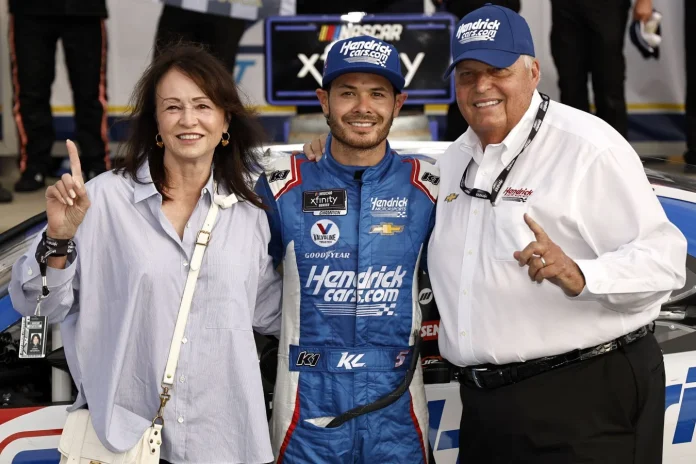A turbulent fallout from the recent Rick Hendrick NASCAR controversy has shaken the racing community, as a disastrous crash at Las Vegas led to the immediate dismissal of Ty Dillon’s veteran spotter, Joe White, from Kaulig Racing. The changes come just days after a pivotal on-track incident drastically altered the playoff outlook, igniting frustration within the Hendrick Motorsports camp and forcing Kaulig Racing into a public personnel shift ahead of Talladega.
On-Track Chaos at Las Vegas Upends Playoff Hopes
During the NASCAR Cup Series event in Las Vegas, chaos unfolded as William Byron, a prominent championship contender for Rick Hendrick’s team, was involved in a collision with Ty Dillon. Byron had been competing for a win, running in second place with 32 laps remaining, when Dillon, driving a slower car, began to slow for a pit stop. In a split second, Byron’s No. 24 Chevrolet made contact with Dillon’s vehicle, sending both spinning and causing severe damage that ended both drivers’ races prematurely. This incident not only dashed Byron’s aspirations for a championship, dropping him 15 points below the playoff cutline, but it also drew significant attention to the role of team spotters in ensuring clear communication on track.
The result of this crash had a profound effect on multiple key figures—Ty Dillon, William Byron, and Joe White—who found themselves at the heart of a debate on responsibility and protocol within NASCAR’s intense playoff stretch.
Immediate Fallout: Spotter Joe White Fired by Kaulig Racing
Days after the Las Vegas race, Joe White, Ty Dillon’s spotter since 2018, was traveling to Talladega Superspeedway when Kaulig Racing CEO Chris Rice called to deliver the news of his dismissal.
“I got fired. I got let go from my position,”
White said in an interview with Jordan Bianchi of The Athletic.
“I’m disappointed but not surprised either, as I knew I wasn’t going back to spot that car next year anyway. (Rice) called and said, ‘How are you doing?’ And I said I was great. And he goes, ‘We’re making a spotter change starting immediately.’”
— Joe White, Ty Dillon’s Spotter
White had been previously informed that his role with the No. 10 Cup Series team would not continue after the current season, and he had been told to expect a transition to Kaulig Racing’s Truck Series program in 2026. Following the incident, however, this potential opportunity was also revoked. White remains under contract and will be paid through the end of the year, but his active involvement with the team has ended immediately.
Kaulig Racing’s roster for upcoming races now lists Frank Deiny as the spotter for Ty Dillon’s No. 10 car, starting at Talladega. Meanwhile, T.J. Bell, previously slated for a future spotter role, has been assigned to A.J. Allmendinger’s No. 16 car. Although Chris Rice confirmed the new assignments, he declined to comment directly on White’s departure.
“Frank Deiny was going to do the 10 car in 2026, and T.J. Bell was going to do the 16 car in 2026. We just decided to move forward with three races to go to get those guys used to each other. And that’s where we stand as Kaulig Racing,”
Rice explained.
Breakdown in Communication: Disputed Accounts From the Spotter Stand
The crash and its aftermath brought a microscope to pit road communication, with multiple perspectives emerging. William Byron voiced frustration over the lack of warning as Ty Dillon slowed abruptly in front of him.
“I didn’t see any indication that he was pitting. It was probably 12 to 15 laps after we had pitted, so I thought the (pit) cycle was fully over. Nobody said anything to my spotter, from what I know. I had zero idea… Obviously, I wouldn’t have just driven full speed into the back of him like that,”
Byron explained. — William Byron, Hendrick Motorsports Driver
Dillon countered that standard protocols had been followed, emphasizing his reliance on spotters to ensure other teams were notified of pit entries.
“Usually, I rely on the spotter to let everybody know, and my spotter said he let (Byron’s) spotter know. I don’t know if it’s a lack of information getting relayed, but that’s a quick amount of time for that to happen. I don’t think I did anything egregious getting on pit road. I hate it for them and hate that it took him out. He was lining up to have a really good day, but I don’t know who that is on or if I could do much different there,”
said Dillon. — Ty Dillon, NASCAR Driver
Joe White asserted he attempted to notify Byron’s spotter, Brandon Lines, but the communication fell short due to their locations on the spotter stand.
“Brandon is at the other end of the spotter stand towards Turn 1, so I was like, ‘I got to get to Brandon.’ So I hustled down there. I didn’t get to him; I didn’t touch him on the shoulder, turn him around, but I got, I would say, four or five feet from him, couple people down, and he turned and looked at me,”
White explained. — Joe White, Ty Dillon’s Spotter
“We made eye contact. I pointed to the bottom, twice, and mouthed the words ‘we’re pitting’ — even though I know he can’t hear and he probably can’t read my lips, but I gestured just like I would do any other person that we’re pitting. Obviously, that was misunderstood. He thought we were giving him the bottom, and that was not the case,”
said White. — Joe White, Ty Dillon’s Spotter
Rudy Fugle, Byron’s crew chief, openly disputed White’s claims about the communication timeline.
“Our spotter didn’t get clear communication and definitely didn’t get that early enough.”
— Rudy Fugle, Hendrick Motorsports Crew Chief
Hendrick Motorsports’ Response and Ongoing Frustration
The incident at Las Vegas left the Rick Hendrick camp fuming and searching for answers. The ensuing discussion spotlighted systemic issues in how pit road communications are managed, especially with the playoffs on the line. Byron’s crash ended his day with a 36th-place finish, while Dillon finished 37th, compounding the disappointment for both teams.
Rudy Fugle had further comments on the broader communication culture within NASCAR:
“I think we just, culture-wise, we all need to do our job of communicating better, but from a driver’s standpoint, there was no hand out the window,”
crew chief Rudy Fugle vented on SiriusXM NASCAR Radio.
“He had the opportunity to, running between the leaders, in a really poor position on, running position on track, he had the opportunity to take a really shallow entry and make sure he was out of the way to hit pit road. All those things are possible and should have been done, in my opinion.”
— Rudy Fugle, Hendrick Motorsports Crew Chief
Despite the disappointment, optimism lingers within Hendrick Motorsports, as Byron’s earlier performance at Las Vegas, which included a Stage 1 win, a third-place finish in Stage 2, and 55 laps led, highlighted the speed and capability of the No. 24 team. Commentator Kyle Petty expressed confidence in Byron’s ability to rebound:
“I think that William Byron can recover from this because we’ve seen the Hendrick cars have speed… I have Byron going all the way to Phoenix.”
— Kyle Petty, NASCAR Commentator
New Lineup and What Lies Ahead For Kaulig and Hendrick Teams
With Joe White’s dismissal following the Rick Hendrick NASCAR controversy, Kaulig Racing moves into the remaining three playoff races with significant changes to its on-track communications team. Frank Deiny’s and T.J. Bell’s assignments, implemented sooner than expected, are intended to give both new spotters a head start in building reliability with their drivers.
Hendrick Motorsports and the wider NASCAR community are left to reflect on the thin margins between clear communication and misfortune, especially under the heightened pressure of the championship run. For William Byron, the challenge now is to overcome a steep playoff deficit, while for Kaulig Racing, the focus turns to stabilizing the organization through personnel upheaval and maintaining competitive spirit in the turbulent final weeks of the season.
The chaos from Las Vegas may offer lessons in communication protocols and team management, as the drama of the 2024 NASCAR playoffs continues to captivate fans and keep the sport’s most influential figures, including Rick Hendrick, under scrutiny heading into the season’s finale.
In this story, fired Ty Dillon spotter @White_Joe47 speaks with @Jordan_Bianchi about his perspective of the William Byron crash last week: https://t.co/DT6oMJveQO
— Jeff Gluck (@jeff_gluck) October 16, 2025


